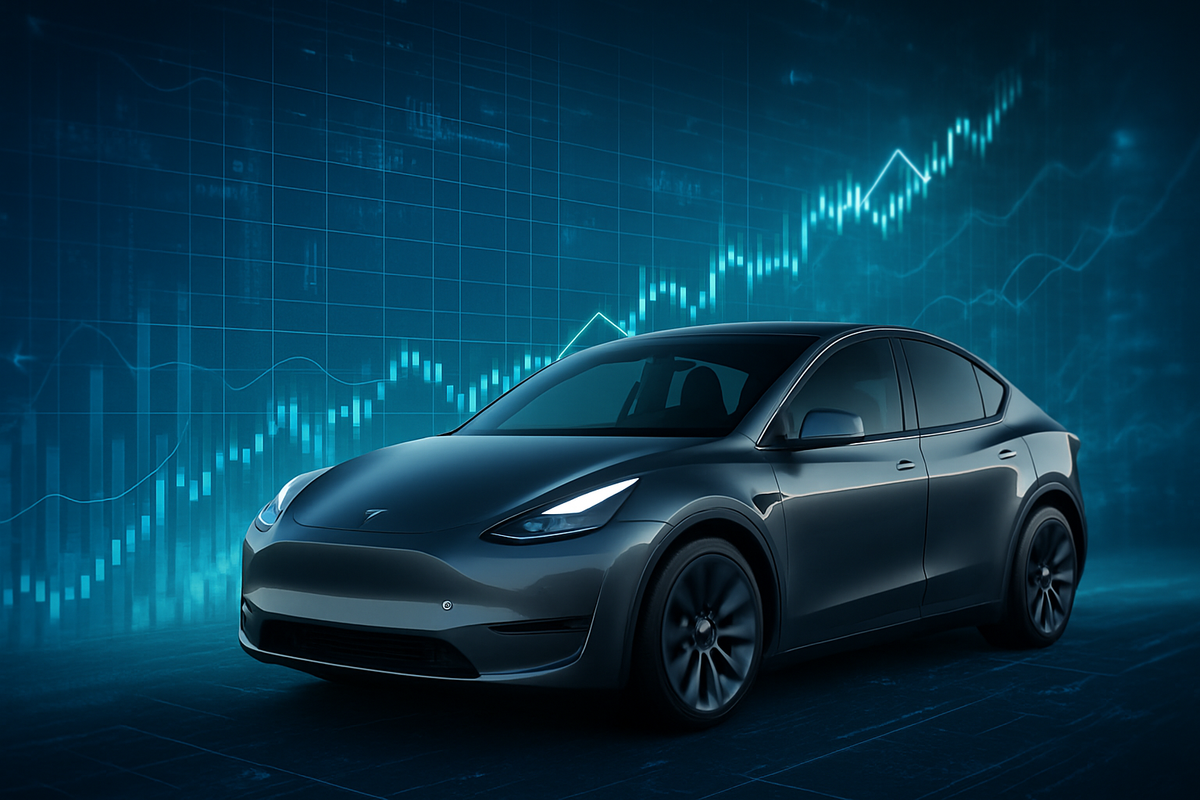
As the third quarter of 2025 draws to a close, all eyes in the financial world are firmly fixed on Tesla (NASDAQ: TSLA), which is poised to announce its Q3 vehicle delivery figures. The period, spanning July 1st to September 30th, has just concluded, and the market is abuzz with anticipation for the official numbers expected on Thursday, October 2, 2025. This announcement is not merely a routine earnings report; it's a pivotal moment that could significantly influence investor confidence, shape near-term market trends, and provide crucial insights into the health of the broader electric vehicle (EV) market.
The market's immediate reaction is expected to be swift and pronounced, reflecting whether the actual deliveries meet, exceed, or fall short of the diverse range of analyst expectations. With Tesla's stock experiencing a notable rally in recent weeks, driven by optimism and strategic moves, the stakes for this report are exceptionally high. Investors are keenly looking for signs of sustained growth and operational efficiency, especially as the industry navigates evolving consumer demand and a competitive landscape.
Q3 2025: A Confluence of Catalysts and Caution
Tesla's Q3 2025 delivery figures are expected to land amidst a complex interplay of market dynamics and strategic maneuvers. Analyst consensus for the quarter generally hovers around 447,000 to 448,000 vehicles, though a spectrum of projections exists, with some bullish forecasts extending as high as 495,000 to 509,000 units. These more optimistic figures, notably from sources like UBS and prediction markets, suggest a strong belief that Tesla could significantly beat Wall Street's more conservative estimates. These expectations represent a substantial sequential improvement over Q2 2025's 384,000 deliveries, though some consensus figures are slightly down year-over-year compared to Q3 2024's 463,000 units.
Several key factors are believed to have influenced Tesla's performance during this critical quarter. A major driver was the expiration of the $7,500 U.S. Federal EV Tax Credit on September 30, 2025. This deadline is widely thought to have pulled forward demand, prompting American consumers to accelerate their purchases to take advantage of the incentive before it vanished. Additionally, the revamped Model Y, featuring design and technological enhancements, is expected to have bolstered sales after earlier production lulls. Tesla also saw strong sales momentum in China, particularly in September, supported by targeted price adjustments despite some year-over-year declines in August. Improved production efficiency across its global factories is also cited as a positive contributing factor.
The immediate market sentiment surrounding these anticipated figures is a blend of optimism and underlying caution. Tesla's stock (NASDAQ: TSLA) has enjoyed a robust rally, climbing nearly 30% in September, fueled by positive analyst revisions and a significant stock purchase by CEO Elon Musk. Many market participants are betting on Tesla to "beat" delivery forecasts. However, a degree of caution persists, with some analysts questioning whether the expected surge in deliveries is primarily due to the pull-forward effect of the expiring tax credit rather than robust organic demand. Concerns also linger about potential softness in Q4 U.S. demand post-tax credit and an observed eight-month decline in European sales. Beyond the Q3 numbers, investors are also keenly observing progress in Tesla's autonomous driving (Robotaxi) initiatives, the Optimus humanoid robot, and the planned introduction of more affordable EV models in the latter half of 2025, which are seen as crucial future catalysts.
Corporate Ripples: Winners, Losers, and the Shifting EV Landscape
The upcoming Q3 delivery announcement from Tesla (NASDAQ: TSLA) carries significant weight, poised to create substantial ripples across the automotive industry, impacting not only the EV giant itself but also its direct competitors and the intricate global supply chain. The figures will serve as a crucial barometer for the health and direction of the electric vehicle market as a whole.
For Tesla (NASDAQ: TSLA), a robust delivery report, particularly one that surpasses the more optimistic analyst forecasts, would undoubtedly ignite a fresh wave of investor confidence. Such an outcome could lead to a further surge in its stock price, which has already seen considerable gains, fueled by the expiring U.S. federal EV tax credit, the revamped Model Y's performance, and ongoing excitement around its autonomous driving and AI ventures. Conversely, a miss on these high expectations or a cautious outlook for Q4 could trigger a sharp stock correction and renewed scrutiny from investors concerned about valuation, margin pressures, and the company's diversified focus beyond core EV manufacturing. Any negative sentiment could also be exacerbated by lingering concerns over CEO Elon Musk's political activities and their potential impact on consumer perception.
Competitors are watching closely. General Motors (NYSE: GM), aggressively expanding its EV portfolio and positioned as the second-largest EV player in the U.S., will face increased pressure if Tesla delivers exceptionally strong numbers. GM's strategy, centered on its Ultium battery platform and a push for more affordable EV models, would need to accelerate to maintain its competitive edge. Similarly, Ford (NYSE: F), which has been electrifying popular models like the Mustang Mach-E and F-150 Lightning, has already adjusted its EV strategy to prioritize profitability amidst high battery costs. A strong Tesla performance might compel Ford to further refine its electrification roadmap, focusing intently on efficiency and competitive pricing, especially given its slimmer EV margins. Meanwhile, the formidable Chinese EV giant BYD (SZSE: 002594), which has already surpassed Tesla in overall new energy vehicle sales, will likely intensify its global expansion and innovation. BYD's strategy of aggressive pricing and technological advancements, such as its "Super e-Platform," directly challenges Tesla's market position, and strong Tesla results will only fuel BYD's drive to redefine the EV market through product innovation and logistical efficiency.
The broader EV supply chain also stands to be significantly affected. Strong delivery numbers from Tesla typically signal sustained demand, translating into increased orders for key suppliers of batteries, semiconductors, and other critical automotive components. This, in turn, can spur these suppliers to boost production capacity and invest further in R&D. Conversely, a downturn could ease demand and pricing pressures on raw materials like lithium, cobalt, and nickel. Tesla's highly integrated supply chain means that its performance directly influences demand for these crucial commodities and the stability of its manufacturing processes, including its Gigafactories. As a market leader, Tesla's Q3 results will also serve as a bellwether for the entire EV industry, potentially influencing investments in charging infrastructure, battery technology, and other related services, while also highlighting the vulnerabilities of the supply chain to geopolitical risks, particularly given Tesla's reliance on China for production and raw materials.
Broader Horizons: Industry Shifts and Policy Implications
Tesla's (NASDAQ: TSLA) Q3 2025 delivery results extend far beyond the company's immediate financial performance; they serve as a critical indicator for the entire electric vehicle industry and its trajectory. The EV market is currently defined by accelerated adoption, intense competition, and relentless technological advancements, all against a backdrop of evolving consumer preferences and persistent supply chain challenges. Tesla's numbers will either affirm the robust growth narrative or highlight emerging headwinds, influencing strategic decisions across the board.
A strong showing from Tesla would underscore the continuing global shift towards electrification, potentially boosting investor confidence in the broader EV sector, including charging infrastructure providers and battery technology innovators. However, it would also intensify pressure on traditional automakers like Volkswagen (XTRA: VOW), General Motors (NYSE: GM), and Ford (NYSE: F) to accelerate their own EV production, innovate faster, and refine their pricing strategies to remain competitive. Conversely, if Tesla's deliveries fall short of expectations, it could signal a broader slowdown in EV demand, leading to a re-evaluation of production targets and investment plans across the industry. Such an outcome might also spark concerns about the sustainability of current EV valuations and the challenges of scaling production profitably. Furthermore, Tesla's pricing strategies, often aggressive, frequently set a benchmark that competitors are compelled to follow, impacting profitability margins across the sector.
From a regulatory and policy standpoint, Tesla's performance holds significant sway. Consistent, robust EV sales, particularly from a market leader, can encourage governments to maintain or even enhance incentives, such as tax credits and purchase subsidies, aimed at accelerating EV adoption. It also reinforces the feasibility of stricter emissions standards and zero-emission vehicle (ZEV) mandates globally. The continued growth in EV sales, spearheaded by companies like Tesla, also highlights the urgent need for expanded charging infrastructure, potentially fast-tracking government and private sector investments in charging networks and grid upgrades. Moreover, the increasing adoption of Tesla's North American Charging Standard (NACS) by other automakers could lead to a de facto industry standard, influencing future regulatory decisions on charging infrastructure requirements and interoperability.
Historically, the performance of dominant players has often dictated the direction of entire industries. One can draw parallels to the early 20th century with the Ford Model T, whose mass production and affordability revolutionized the automotive industry, forcing competitors to adapt or perish. Similarly, the success of Japanese automakers in the 1970s and 80s compelled American manufacturers to drastically improve quality and efficiency. In the technology sector, Apple's (NASDAQ: AAPL) iPhone fundamentally reshaped the mobile phone market, while Microsoft's (NASDAQ: MSFT) dominance in the PC era influenced hardware and software development for decades. Tesla's quarterly delivery announcements have consistently served as a critical temperature check for the enthusiasm surrounding EVs and disruptive technologies, and Q3 2025 will be no different, offering crucial insights into the evolving landscape of global transportation.
The Road Ahead: Navigating Tesla's Future Trajectory
The Q3 2025 delivery announcement will serve as a critical juncture for Tesla (NASDAQ: TSLA), setting the tone for its immediate future and providing insights into the viability of its ambitious long-term vision. In the short term, a strong delivery report, particularly one that exceeds the optimistic analyst forecasts ranging from 447,000 to 475,000 units, would significantly boost investor confidence. This positive momentum would be crucial as the company continues to ramp up Cybertruck production and prepares for the anticipated launch of its new, more affordable models, often dubbed "Model 2" or "Model Q," in the latter half of 2025. Conversely, a weak Q3 performance could trigger increased market skepticism, especially given the expected demand pull-forward from the expiring U.S. federal EV tax credit, potentially leading to a more challenging Q4.
Looking further ahead into 2027 and beyond, Tesla's trajectory is increasingly defined by its strategic pivot from a pure EV manufacturer to an "autonomous mobility platform" and "full-stack AI physical infrastructure firm." This long-term vision hinges on the successful development and deployment of its Robotaxi network, with a fully functional service planned for mid-2026, and the mass rollout of Optimus humanoid robots by 2030, potentially starting external sales in late 2025 or early 2026. These ventures, alongside the continued expansion of its energy storage business with products like Megapack, represent massive new market opportunities, particularly with the surging demand for AI infrastructure. The successful introduction of mass-market vehicles on its next-generation platform will also be pivotal for achieving its audacious goal of producing 20 million vehicles annually by 2030, expanding beyond its current Gigafactories in Berlin, Shanghai, and Texas.
However, this ambitious future is not without its challenges. Tesla must skillfully navigate intensifying competition, especially from aggressive Chinese EV manufacturers like BYD (SZSE: 002594), which are eroding market share. This will necessitate continuous innovation, potentially faster product refresh cycles, and strategic pricing adjustments. Overcoming manufacturing complexities for new models like the Cybertruck and the next-gen platform, coupled with ensuring a stable supply chain for critical components like 4680 battery cells, will be paramount. Furthermore, the success of its FSD (Full Self-Driving) and Robotaxi initiatives depends not only on technological breakthroughs but also on navigating complex and varied global regulatory landscapes. The company's ability to effectively allocate capital to these diverse, high-growth areas while maintaining its core automotive profitability will determine whether it can truly transform into the AI and robotics powerhouse it envisions, or if it will remain primarily an EV company facing growing market pressures.
The Verdict Awaits: A Defining Moment for Tesla and the EV Market
As October 1, 2025, draws to a close, the financial world stands on the precipice of a pivotal moment for Tesla (NASDAQ: TSLA), with its official Q3 2025 production and delivery numbers expected to be unveiled tomorrow, October 2, 2025. This report will not merely be a reflection of the past quarter's performance but a crucial determinant of Tesla's immediate market trajectory and a significant barometer for the health of the broader electric vehicle industry.
The key takeaway from the pre-announcement buzz is a widespread expectation for a strong sequential improvement in deliveries, with analyst consensus around 447,000 to 448,000 vehicles, and some optimistic forecasts pushing towards 475,000 to even 509,000 units. This anticipated surge is primarily attributed to a significant "pull-forward" of demand in the U.S. due to the expiring federal EV tax credit, coupled with the positive impact of the refreshed Model Y, efficient production ramp-ups, and robust demand in China. However, underlying concerns about demand sustainability post-tax credit and observed weakness in the European market temper this optimism.
Moving forward, the market faces a complex landscape. The immediate challenge will be navigating a potential slowdown in U.S. demand in Q4 2025, following the expiration of the tax credit. Tesla's ability to maintain momentum will heavily rely on the successful launch and ramp-up of new, more affordable models and the continued progress of its Cybertruck production. Beyond automotive, the market will increasingly scrutinize Tesla's strategic pivot towards AI and robotics, with the development of its FSD software, Robotaxi network, and Optimus humanoid robots becoming central to its long-term valuation. The consistent profitability and growth of its energy storage business also represent a vital, often underestimated, diversifier.
In conclusion, the Q3 2025 delivery announcement is a defining moment for Tesla. While a strong report could validate its premium valuation and strategic direction, the lasting impact will hinge on its ability to sustain growth in an intensely competitive market, successfully execute its ambitious AI and robotics initiatives, and effectively manage its global supply chains. Investors should closely monitor the official Q3 numbers, management's Q4 guidance, progress on new model launches and Cybertruck production, advancements in FSD and Optimus, and critically, any signs of stabilized or improving profit margins. The coming months will reveal whether Tesla can truly transcend its role as an EV manufacturer to become the AI and energy conglomerate it aspires to be.
This content is intended for informational purposes only and is not financial advice





